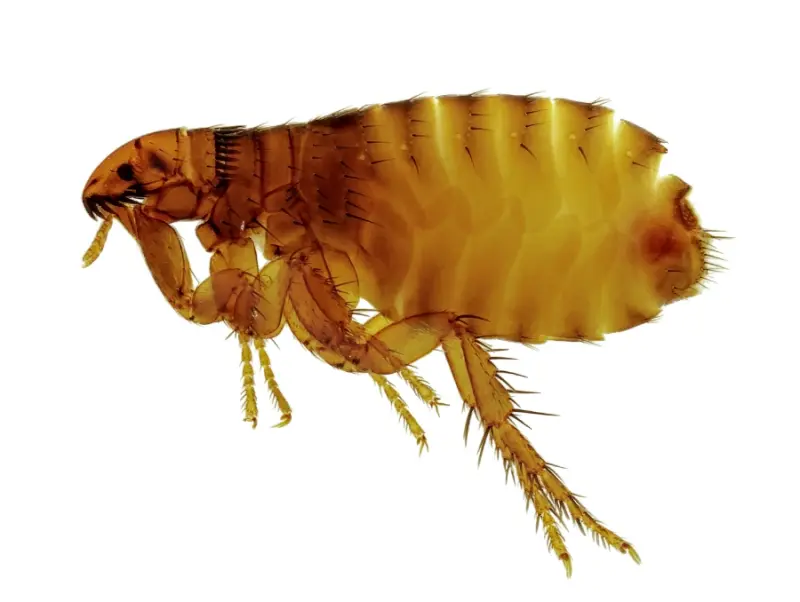Why are fleas a serious problem? This article explores the dangers of fleas and the health issues caused by fleas in pets.
What are the Dangers of Fleas?
Having fleas in your home is a dangerous thing, and they can quickly invade and grow in numbers. Fleas are parasites and live by hematophagy as they suck blood from a host.
They have adapted to feed on various species and other animals, ranging from dog fleas, cat fleas and even human fleas, being a threat across the UK.
Fleas have become incredibly versatile at movement as they've evolved. Fleas jump vertically, approximately seven inches and cover more than a foot in distance. Considering that they are only 1/6 of an inch long, they can cover incredible amounts of ground.
What does this mean for you, though? What dangers do fleas present?
Whether you're concerned for the health of your pet, yourself and want to avoid skin irritation, flea bites, tapeworms and many more dangers, this article is for you.
Health Issues In Pets Caused By Fleas
A large portion of the pet product industry is devoted to helping pet owners remove and eliminate fleas from their pets. Fleas are a common pest in the UK and can lead to scratching, discomfort and infection of the skin in our dogs and cats.
Fleas are incredibly small and will hide in fur, bedding, carpets and anywhere else you don't suspect them. Flea treatment may be second nature to you as a pet owner, but there are severe risks if you are not treating your pets.
Here are five main health issues that fleas can cause in your pets:

Tapeworms

Flea Allergy Dermatitis

Cat Scratch Fever

Anaemia

Feline Infectious Anemia
What causes a flea infestation?

There is little you can do to stop fleas from entering your home, especially when you own a pet. If you're taking your dog or cat outside regularly, fleas will hop from infected areas of grass and shrubbery, or even dirt and into your pet's fur.
Of course, you can also bring them into your home, and they will hide in your clothing, hair and then move to bedding, carpets and furniture.
Fleas can be spotted, though, but they are small. Measuring on average 1/6 of an inch, they can be challenging to spot. They will typically be a reddish-brown colour and don't have wings as they hop from host to host.
Once they have moved to a new host, if that's you or your pet, they can begin feeding within five minutes.
This can continue, and you can lose blood for nearly three hours if you haven't noticed before then. The implications and problems ranging from that are more severe than you believe.
They like to hide in the fur of your pet and can be transferred easily from their underbelly to your carpet and the pet's bedding.
This is how infestations start, as you will not be able to notice one flea, but a larger group will become more apparent, especially once the symptoms set in.
You should be checking your pet's fur with a fine-toothed comb for fleas and get rid of the ones you notice. From there, keep an eye on the treated areas for further irritation.
Fleas love moist, warm areas in your home and will typically become more of a pest over the summer. This is the reason why you will see a lot more fleas in warmer climates.
While your home will continue to provide warmth and shelter for fleas throughout the winter months, you may notice a decrease in flea activity throughout that time.
Flea Multiplication
You may not see the risk of having one flea in your home, but it won't stay that way for long. Where one flea is present, more fleas are there, and they can breed at exceptional rates.
Female fleas lay eggs every day for nearly 50 days in their breeding season, sometimes producing up to 50 a day. Throughout the lifetime of a female flea, this can create over 2,000 eggs and adult fleas.
These flea eggs will be near impossible to spot, as will the flea larvae. A flea egg is, however, notably oval-shaped and can be recognised as such.
As you will have difficulty finding the fleas in the first place, they can quickly have multiplied into several thousand or tens of thousands before you get to the root of the problem.
It's worth noting, though, that the adult stage will only develop in the right conditions and will remain as cocoons until then, so you have a window of time to prevent them from hatching and causing more problems.

The heat and carbon dioxide levels must be right for the pupae or cocoons to hatch. The overall flea life cycle can last anywhere from weeks to months before they develop fully.
From there, the adult fleas begin feeding on hosts, hopping from body to body, and breeding further until your house is overrun with flea infestations.
Fleas live in various strange and small places, so you could be experiencing nesting and breeding currently.
What are the signs of a flea infestation?
If you are concerned about fleas in your home, here are some telltale signs that you could be dealing with an infestation.
Fleas hopping on your carpet and furniture. Although you won't notice a flea most of the time until you are conducting a routine check on your pet, you can sometimes see these small insects hopping on your carpet, bedding or furniture.
Pets excessively scratching This is perhaps the most common sign that your pet has fleas in its fur, as they will begin to lick, scratch or bite at their fur more than normal. This is a sign they are distressed and can feel the fleas on their skin, so you should inspect and use some flea repellent or drops.
Tiny dots in your pet's fur. If you can notice small dots in your pet's fur, this is a sign of fleas. This can be more challenging in animals with darker fur, but you can still spot fleas moving around and take action before something worse happens.

Good flea control in your home is the most important thing to remember. Fleas thrive in warm and moist areas, which is unavoidable over the summer.
You should be routinely checking your pets, whether they are showing any signs or symptoms or not and changing your bedding regularly. This is important as fleas feed on your blood also, which can happen overnight when you're sleeping.
You and your pets can experience a severe allergic reaction to fleas being in your home, along with intense itching and other symptoms.
A flea can consume well over its body weight in blood over a session, leaving you and your pets feeling lightheaded and drowsy. If you experience any of these symptoms, you and your house should be treated immediately.
Hiring a professional exterminator can help in controlling fleas, and they will have greater knowledge on how to kill fleas.
Many flea products and chemicals needed to eliminate them from your home can only be used by a licensed professional and cannot be bought over the counter.
If you continue to suffer from flea infestations, please reach out to our team today. We have a team of experienced flea pest control specialists and can use poisons to eliminate any size of flea infestation.
Pest Control Hampshire are pest control specialists working throughout Portsmouth, Southampton, Basingstoke And Hampshire. Contact us for pest control Basingstoke.
Follow the links below to find a pest control specialist to help resolve your pest infestation.

